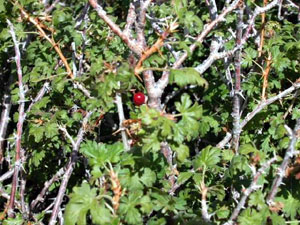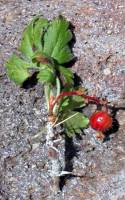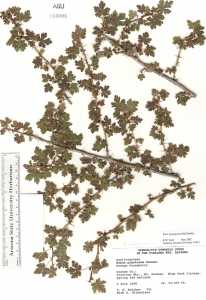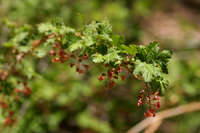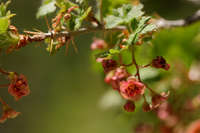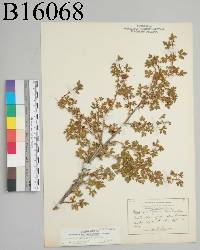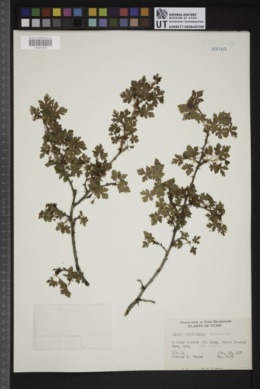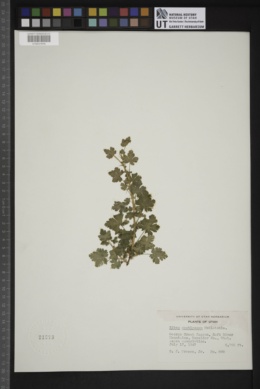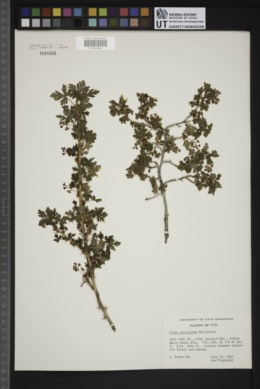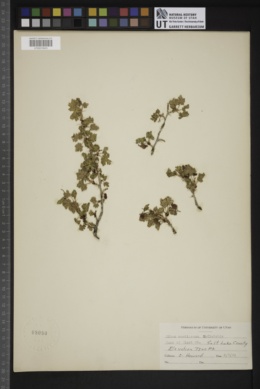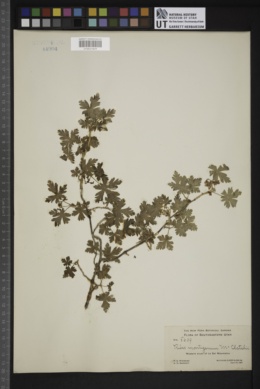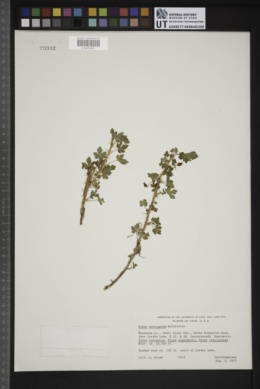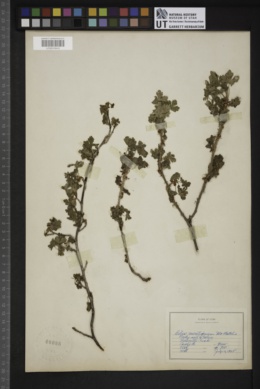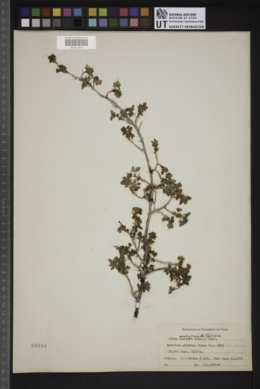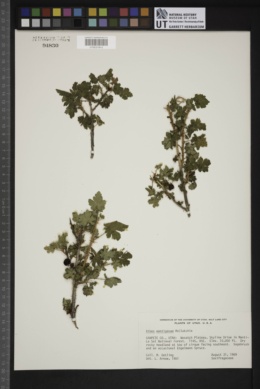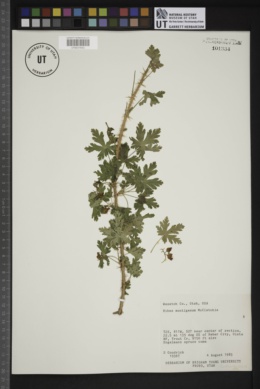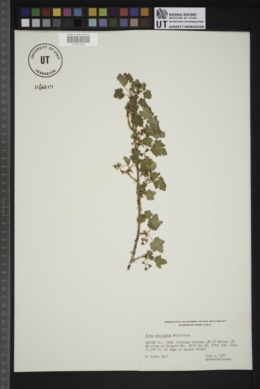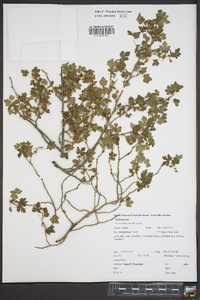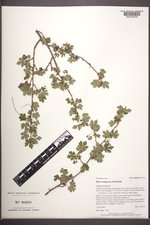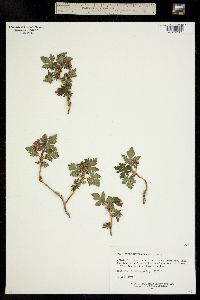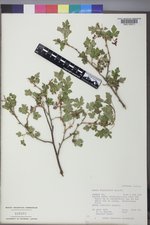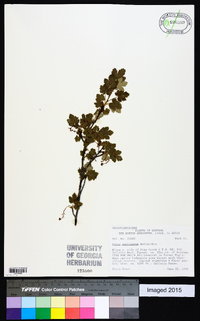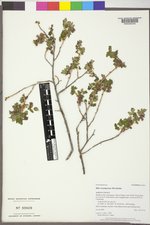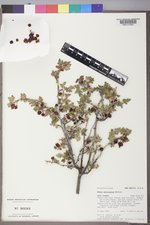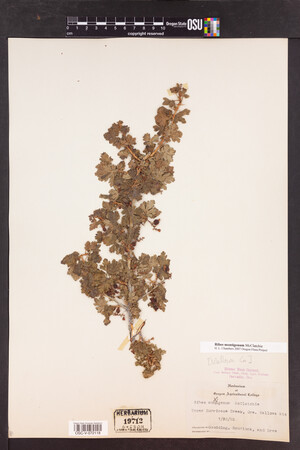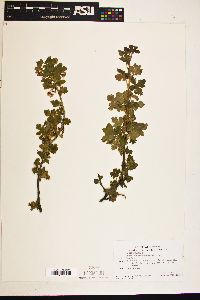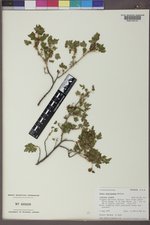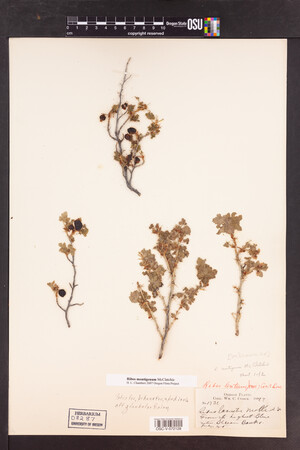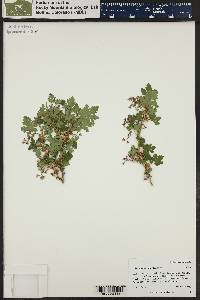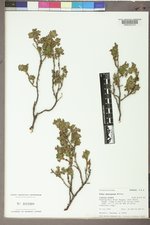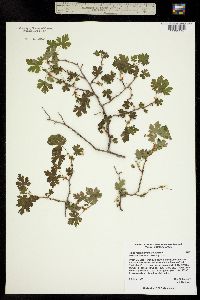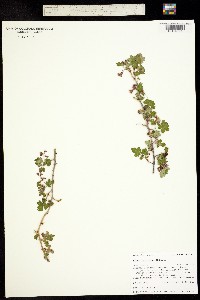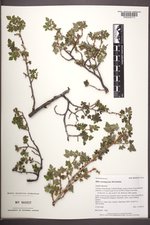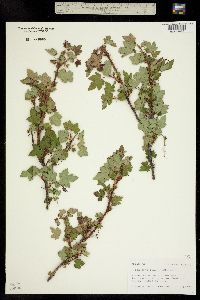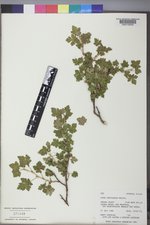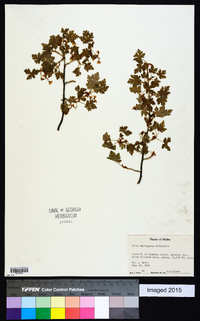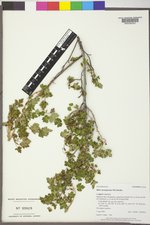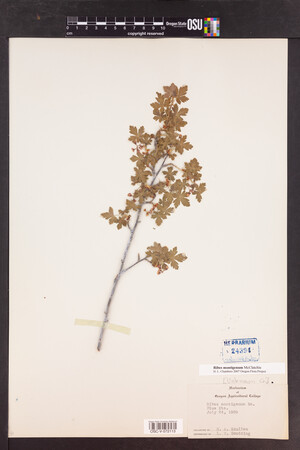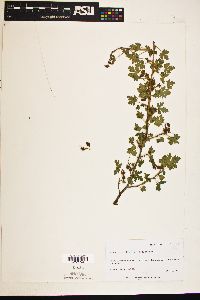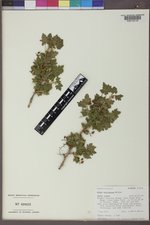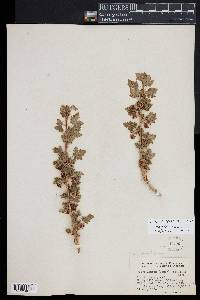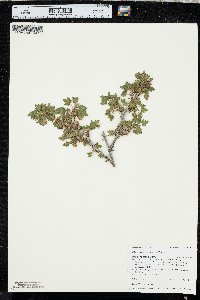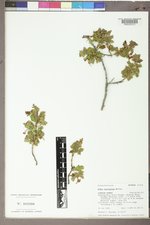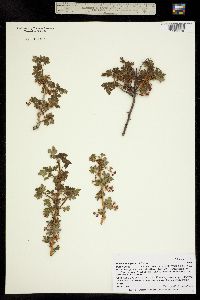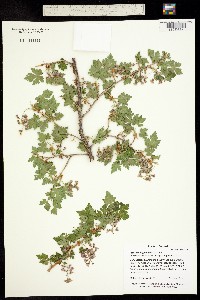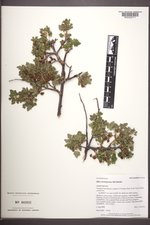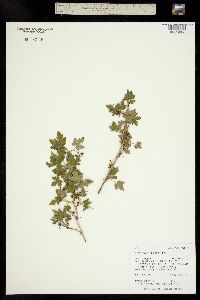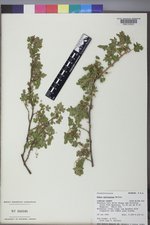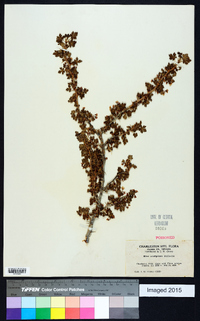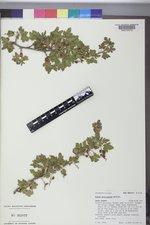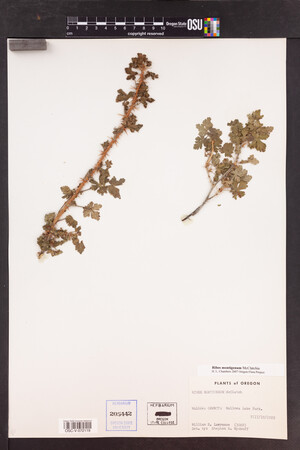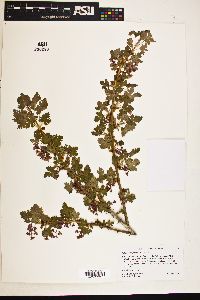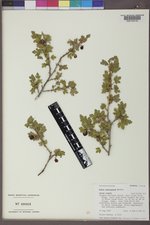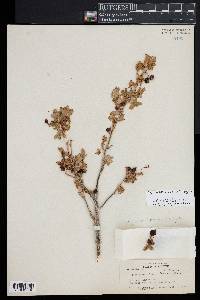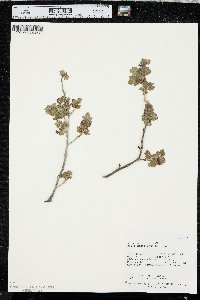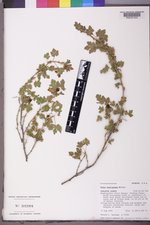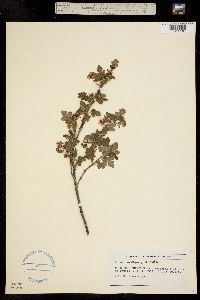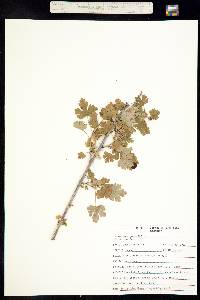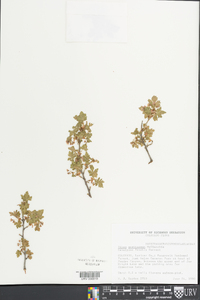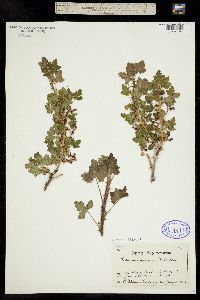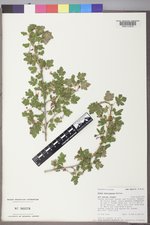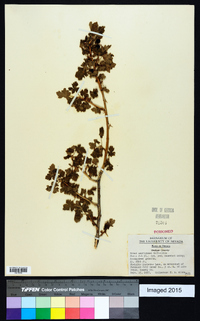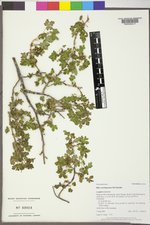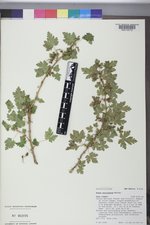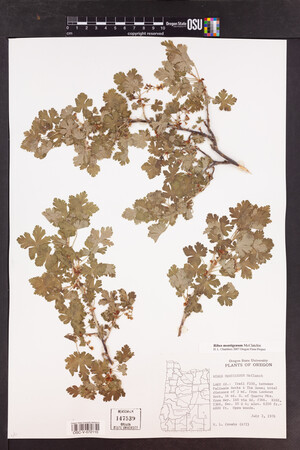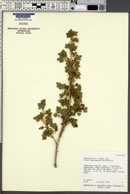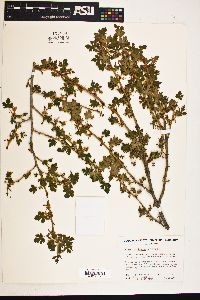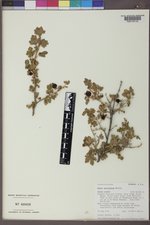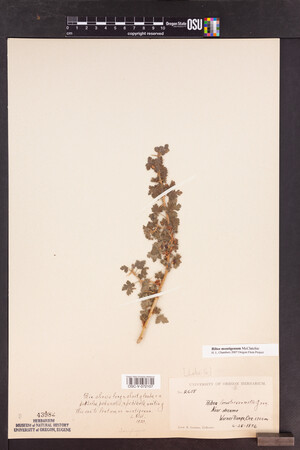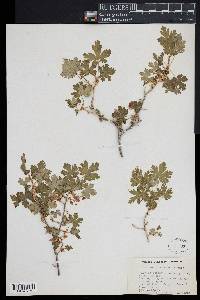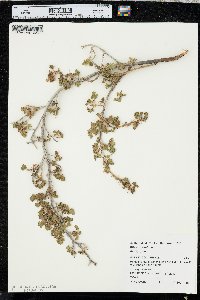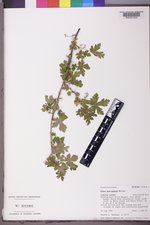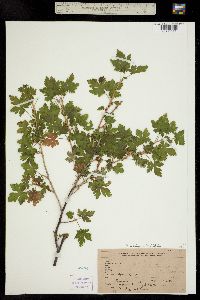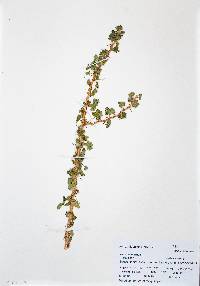Ribes montigenum
|
|
|
|
Family: Grossulariaceae
gooseberry currant, more...Western Prickly Gooseberry, alpine prickly currant, gooseberry current, mountain gooseberry
[Limnobotrya montigena (McClatchie) Rydb., moreRibes lacustre var. lentum M.E.Jones, Ribes lacustre var. molle A. Gray, Ribes lentum (M.E. Jones) Coville & Rose, Ribes nubigenum McClatchie] |
Plants 0.7-1.5 m. Stems spread-ing or decumbent, copiously pubescent, puberulent, and stipitate-glandular; spines at nodes 1-5, (1.5-)4-6(-10) mm; prickles on internodes sparse to dense. Leaves: petiole 0.7-4(-5) cm, pubescent, stipitate-glandular; blade pentagonal, irregularly 5-lobed, cleft 2/3-3/4 to midrib, (0.5-)1-3.5(-4) cm, base cordate, surfaces densely pubescent or stipitate-glandular, lobes cuneate-rounded, margins irregularly serrate, toothed apex somewhat acute. Inflorescences pendent, 3-8 (-11)-flowered racemes, 2-3 cm, axis puberulent, stipitate-glandular, flowers evenly spaced. Pedicels jointed, 1-4(-5) mm, puberulent, stipitate-glandular; bracts lanceolate-ovate, 1.3-3 mm, puberulent, stipitate-glandular. Flowers: hypanthium pinkish to orangish, saucer-shaped, 0.5-1.5 mm, pubescent and stipitate-glandular abaxially, glabrous adaxially; sepals separated, spreading, green to yellowish, pink, red, orange, or white, sometimes with pale yellow, scarious margins, broadly ovate to obovate, 2.5-4 mm; petals widely separated, erect, red, pinkish, or purplish, cuneate-lunate, not conspicuously revolute or inrolled, 0.9-1.5 mm; nectary disc yellowish, pinkish, or red, flat, 5-angled, covering most of ovary; stamens as long as petals; filaments linear, (0.5-)0.9-1.6 mm, glabrous; anthers yellow or cream, oblate to transversely elliptic, 0.5-0.8 mm, broader than long, apex notched; ovary sparsely to thickly, usually purplish glandular-bristly; styles connate ca. 4/5 their lengths, 1.1-1.8 mm, glabrous. Berries somewhat palatable, bright red, obovoid-spheric, 5-10 mm, glandular-bristly. Flowering Jun-Aug. Exposed ridges, open woods and slopes, talus; 1300-4800 m; B.C.; Ariz., Calif., Colo., Idaho, Mont., Nev., N.Mex., Oreg., Utah, Wash., Wyo. The lobed, yellowish, pinkish, or red nectary discs and purplish red filaments of Ribes montigenum are striking.
Common Name: mountain gooseberry Duration: Perennial Nativity: Native Lifeform: Shrub General: Deciduous shrub, 0.2-1 m (0.7-3 ft) tall; armed with 3-5 nodal spines, these straight, 2.3-8 mm long, usually with internodal bristles; stems sprawling to weakly ascending; branches gray, becoming reddish brown with age; twigs tan, occasionally slightly pubescent. Leaves: Alternate, simple, circular to pentagonal in outline, 0.4-3.5 cm long, 0.6-5 cm wide, deeply 5-lobed to divided, green above, pale green below, densely pubescent with glandular and non-glandular hairs on both surfaces, margins crenate-dentate; petioles 0.4-4 cm long. Flowers: Racemes 3-8 flowered; subtending bracts lanceolate, 1.3-3 mm long; pedicels 1-4 mm long, non-glandular and glandular pubescent, jointed below the ovary; ovary glandular-bristly; hypanthium saucer-shaped, 0.5-1.5 mm long, greenish white or purplish; calyx lobes 2.5-4 mm long, usually purplish, spreading; petals 1-1.5 mm long, purplish; stamens about equaling the petals; styles glabrous. Fruits: Berry, nearly globose, 5-10 mm in diameter, purplish red, with glandular bristles, dry; seeds numerous, 1.5-2.8 mm long. Ecology: Found in montane, subalpine, and alpine habitats, open slopes or exposed ridges from 6,500-11,500 ft (1981-3505 m), flowers June-August. Distribution: Apache, Coconino, and Graham counties; western Canada, western U.S. Notes: The plant provides food for birds, chipmunks, and ground squirrels, and is a host plant for the tailed copper butterfly. Editor: Springer et al. 2011 |

